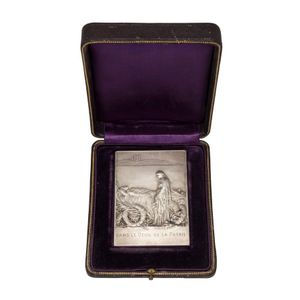Art Deco Emerald and Diamond Scarab Ring
You must be a subscriber, and be logged in to view price and dealer details.
Subscribe Now to view actual auction price for this item
When you subscribe, you have the option of setting the currency in which to display prices to $Au, $US, $NZ or Stg.
- Emeralds - Emeralds have been used in jewellery making for thousands of years, and are prized for their deep green colour, which is caused by the presence of chromium and vanadium in the mineral beryl. Because of their rare colour, emeralds are often more valuable than diamonds of a similar size and quality. In jewellery making, emeralds are typically cut into round or oval shapes to maximize their color and clarity. They are often set in gold or platinum and used as the centrepiece of a piece of jewellery, such as a ring or necklace. They can also be used in combination with other gems, such as diamonds, to create intricate and beautiful designs.
- Scarab Beetle - xx
- Carat - A carat (abbreviated "ct") is a unit of measurement used to describe the weight of a diamond or other gemstone, and separately is a unit of measurement used to describe the weight of precious metals such as gold,.
For gemstones, one carat is equal to 0.2 grams or 200 milligrams. The weight of a diamond is one of the Four Cs (along with cut, colour, and clarity) that are used to determine a diamond's value.
It is important to note that a diamond's weight does not necessarily correspond to its size. A diamond's cut, which affects how well it reflects light, can make a diamond of a lower weight appear larger than a diamond of a higher weight. Additionally, the carat is not the only factor to determine the value of a diamond, other factors such as clarity, colour and cut are important too.
In the gold industry, the purity of gold is measured in carats (abbreviated "ct"), with 24 karats being pure gold and lower carat numbers indicating a lower purity level. So, for example, 18 carat gold is 18/24 or 75% pure gold, and 12 carat gold is 12/24 or 50% pure gold. - Millegrain - A type of jewellery setting where the stone is held is held in position by small adjacent beads of metal. This method of securing the stone was popular in the 19th century.
- Cabochon Cut in Jewellery - A cabochon cut is a type of gemstone cutting where the stone is cut and polished in a convex shape with a flat bottom and a domed top, with no facets. This type of cut is typically used for opaque or translucent stones that have natural patterns or inclusions that are best displayed in this type of cut. Examples of stones that are often cut as cabochons include turquoise, opal, and moonstone.
- Art Deco Period - The Art Deco period was a cultural movement that emerged in the 1920s and 1930s, and was characterized by its emphasis on modernism, luxury, and elegance. The name "Art Deco" comes from the Exposition Internationale des Arts Décoratifs et Industriels Modernes, a large exhibition held in Paris in 1925 that showcased the latest trends in decorative arts.
Art Deco was a reaction against the ornate and elaborate styles of the previous era, and reflected a new modern sensibility. It was characterized by streamlined, geometric shapes, bright colours, and the use of new materials such as chrome, glass, and Bakelite. Art Deco designers sought to create a sense of luxury and sophistication, often incorporating expensive materials such as ivory, marble, and rare woods.
Art Deco had a significant impact on a wide range of artistic fields, including architecture, fashion, graphic design, and interior design. Some of the most iconic examples of Art Deco architecture include the Empire State Building in New York City, the Hoover Building in London, and the Palais de Chaillot in Paris.
The Art Deco period came to an end in the 1940s, as World War II and changing cultural trends led to a shift in artistic styles. However, Art Deco remains an important influence on design and art, and continues to be celebrated for its modernist sensibility and glamorous aesthetic.
This item has been included into following indexes:
- Art Deco jewellery - rings, mixed stones 408
- jewellery - scarab and beetle design 111
-
rings, diamond
- diamond and emerald 1,172
- diamond and emeralds 2,158
Visually similar items

Boxed pair of antique silver plate knife rests (2)

An antique opal and diamond ring, the oval solid white opal cut en cabochon, flanked by two old rose cut diamonds, mounted in 15ct gold, hallmarked, ring size S. Condition: ring presents in good condition and stones are secure in their settings. Shank has

Sterling silver photo frame, 11 x 8 cm. London hallmarks

France: The Funeral of President Carnot, 58 x 81 mm, silvered-bronze, by Roty. Obverse: The slain president lies in state, attended by a mournful goddess (France); above, a landscape with basilica and date; at bottom, 'The Country in Grief.' Reverse: The c
